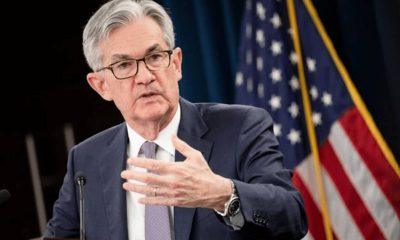Forex
How China talked markets out of a run on the yuan
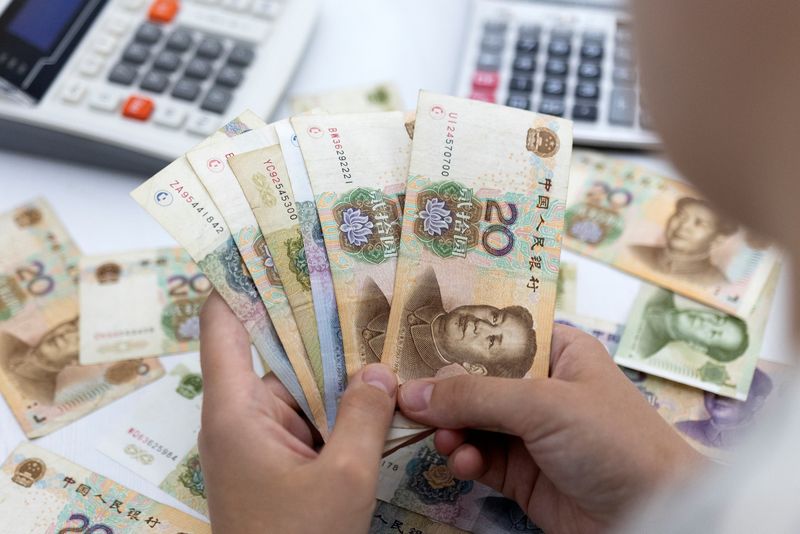
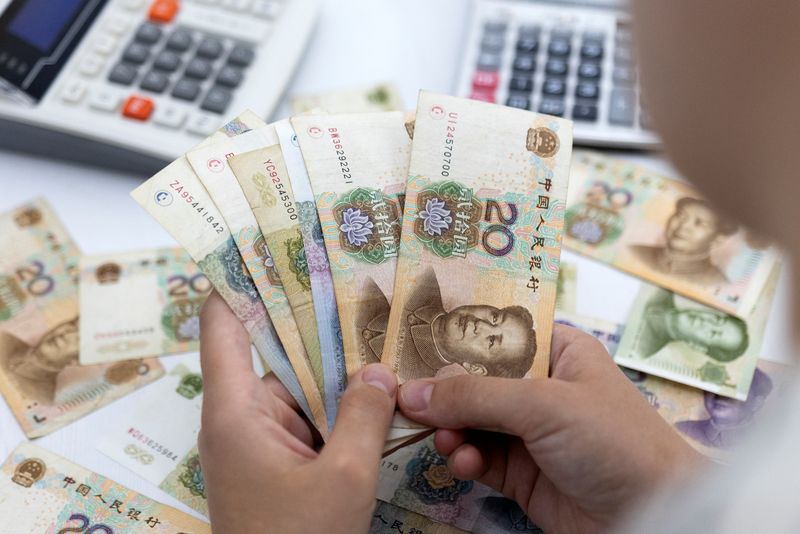
© Reuters. FILE PHOTO: Woman holds Chinese Yuan banknotes in this illustration taken May 30, 2022. REUTERS/Dado Ruvic/Illustration/File Photo
SINGAPORE (Reuters) -In recent months, China has sought to stabilise the yuan by orchestrating buying by state banks and giving market guidance to bankers.
The strategy of moral suasion marks a sharp break from Beijing’s approach the last time the currency was on the ropes, in 2015.
Back then, the People’s Bank of China (PBOC) resorted to official intervention as the central bank burned $1 trillion in reserves to shore it up.
This year, as China’s economy wobbled and money left the country, the PBOC took a starkly different approach, defending the currency by signalling to markets what kind of selling it would and would not tolerate.
Interviews with 28 market participants show at least two dozen cases where regulators closely and frequently steered market participants through a range of co-ordinated actions this year to resist strong downward pressure on the yuan.
The PBOC and State Administration of Foreign Exchange, the currency regulator, did not respond to Reuters’ faxed questions about its approach. PBOC governor Pan Gongsheng has previously said regulators would prevent exchange rate overshooting risks and maintain stable FX market operations.
The strategy market participants and analysts described to Reuters has prevented a destabilising yuan slide.
However, they told Reuters that it has also chilled large parts of China’s foreign exchange market, crashing trading volumes and raising questions about the yuan’s chances of becoming a global reserve currency.
“The circumstances … at the moment are considerably more complicated because there are both domestic as well as global macroeconomic factors,” said Eswar Prasad, Tolani senior professor of international trade policy at Cornell University.
He described the PBOC’s use of “non-standard measures to intervene in foreign exchange markets” as a form of “triage” to stop the yuan falling too rapidly.
As the currency of the world’s second-largest economy and biggest exporter, the yuan’s value determines the price of goods around the world and trillions of dollars in capital flows. It also serves as a barometer of China’s challenges.
A Chinese forex regulator, speaking on condition of anonymity, said the currency’s value was ultimately determined by fundamentals and currently a product of how “effectively China can thwart decoupling”, a reference to Western efforts to reduce economic reliance on China.
Ten traders interviewed by Reuters said key warnings first emerged in June when the PBOC’s daily yuan guidance that determines its trading range for the day, known as the midpoint, started to diverge from market expectations.
In theory, the midpoint is based on contributions from 14 banks and referenced to the previous day’s trade and overnight moves, which should make it easy for markets to predict.
By August, however, the midpoint’s yawning deviation from trader estimates was read by the traders interviewed by Reuters as a signal the PBOC did not want the currency to go where markets were pushing it.
AGAINST THE TIDE
Managing a currency can be a white-knuckle ride. In 2015, China cut the yuan’s midpoint by 2%, with the PBOC saying it was a one-off move to bring the trading band in line with market pricing. Fearing further devaluations, however, investors sold Chinese assets, sending stocks and the yuan into freefall and forcing the bank to use reserves to stabilise the currency. This time, efforts to manage the yuan involved more targeted and specific directions to banks and currency market participants, according to the traders who spoke to Reuters.
For example, whenever momentum seemed against the yuan, state-owned banks quietly became buyers, the traders said. This generally happened around psychologically significant currency levels and seemed aimed at containing volatility. Those traders told Reuters that in late May they noticed state banks stepping in with two days of yuan buying after the currency hit its lowest then for 2023.
Similarly, state banks’ yuan buying intensified in December after Moody’s announced a cut in China’s ratings outlook. Individual traders were not able to estimate the size of buying nor was Reuters able to confirm whether such trading was directed by the central bank.
Official data shows no evidence the PBOC sold dollars outright as it did in 2015. However, market participants noted banks sold dollars acquired by currency swaps, which would not be seen in such data.
At the same time, smaller lenders have experienced increased “window guidance” or unofficial, verbal advice from regulators to have both banks and their clients reduce dollar holdings, according to six trader and banking sources.
In June and July, the China FX Market Self-Regulatory Framework, which is overseen by the PBOC, told major state-owned banks to cut dollar deposit rates, which would encourage exporters and households to switch dollar receipts into yuan, market watchers said.
WORKING THE PHONES The pressure on bankers has mirrored pressure on the yuan, which is down almost 2.8% against the dollar this year even though the benchmark lost 2.2%.
On Sept. 8, the yuan struck a 16-year low. A few days later, managers at eight major banks were summoned to Beijing to meet PBOC officials, according to five banking sources, two of whom attended the meeting. They were told companies wishing to buy more than $50 million would need approval from the PBOC, three sources said. Bankers were also told they needed to cut spot trading, stagger dollar buying and not hold net long dollar positions at the end of any trading day, two sources said.
Authorities also focused on monitoring exporters’ foreign exchange buying and selling plans given their large currency holdings and outsized sway on yuan moves.
In recent months, regulators have called banks and queried them with surveys on a near weekly basis on the intentions of exporter customers, according to officials at five banks who spoke to Reuters. Such calls had previously been sporadic and surveys sent only monthly.
The volume of yuan traded onshore slumped 73% from August’s level to a record low of 1.85 trillion yuan in October. That shows China’s bankers have heeded the call to reduce trading, particularly dollar buying, but also that the central bank’s efforts are chilling the market, analysts say.For now, however, the currency appears to have stabilised comfortably above September’s 16-year low.
Market players are unwilling to directly fight the PBOC — but nor are they willing to acquiesce entirely.
“I’ve been closely monitoring dollar prices this year, as I have dollar payments coming in every few weeks,” said one Shanghai-based exporter of electronic components surnamed Zhu. “The daily question has been: ‘Do I need to save them, or convert them back into yuan?'” So far, she has saved them on expectations of a better yuan price for her dollars.
Forex
Dollar slips before Fed meeting statement
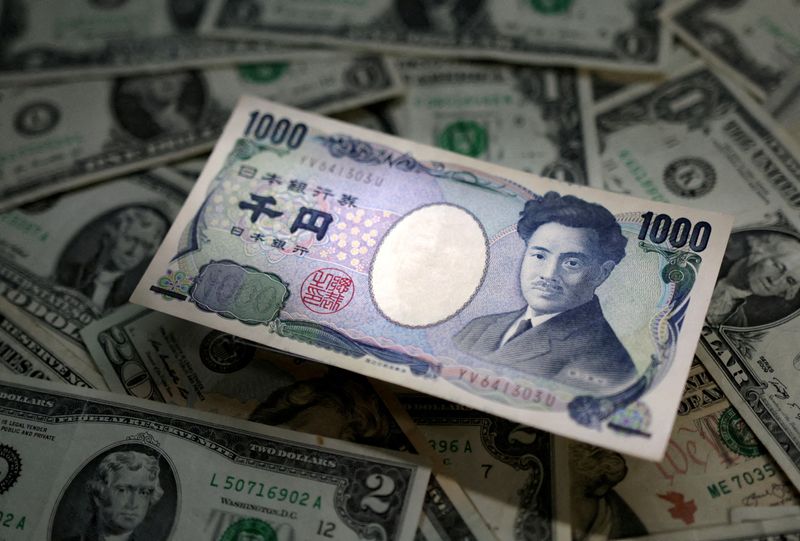
By Karen Brettell
NEW YORK (Reuters) – The dollar slipped on Wednesday ahead of the conclusion of the Federal Reserve’s two-day policy meeting, with investors focused on whether Fed Chair Jerome Powell will adopt a more hawkish tone as inflation remains stubbornly above its 2% annual target.
Stickier than expected consumer price inflation in March dashed hopes that elevated readings in January and February were anomalies, leading traders to push back expectations on when the U.S. central bank is likely to cut interest rates.
Fed fund futures traders price in only one rate cut this year, with a roughly 50% probability it will occur in September. Traders had previously expected three rate cuts this year, likely beginning in June.
The fell 0.11% to 106.20, after earlier reaching 106.49, the highest since April 16. A break above the 106.51 would be the highest since early November.
“The market is clearly concerned that the Fed will take some hawkish steps,” said Adam Button, chief currency analyst at ForexLive in Toronto.
However, Powell is unlikely to put the prospect of new interest rate hikes on the table on Wednesday, and is instead likely to promote holding rates higher for longer.
That could disappoint investors and send the dollar lower against peers.
“We’ve seen this play out dozens of times where the market gets frightened about a hawkish Fed and then Powell is neutral or dovish,” Button said.
The ADP Employment report on Wednesday showed that U.S. private payrolls increased more than expected in April while data for the prior month was revised higher.
remove ads
.
A U.S. Labor Department report, meanwhile, showed that job openings fell in March.
Separately U.S. manufacturing contracted in April amid a decline in orders after briefly expanding in the prior month, while a measure of prices paid by for inputs approached a two-year high.
The euro gained 0.14% to $1.0682. The pound weakened 0.09% to $1.2479.
The dollar fell 0.17% to 157.53 yen.
The Japanese currency rallied sharply on Monday, with traders citing yen-buying intervention by Japanese authorities to try to underpin a currency languishing at levels last seen over three decades ago.
The dollar has since crept higher, raising questions on whether additional steps will be needed to stop further yen weakness. The Japanese currency is suffering from a wide interest rate differential that makes borrowing in the yen and investing in U.S. assets attractive.
“There aren’t many options for Japan. In one way intervention is just an invitation to buy the dip for most FX traders at better levels,” said Button. “Dollar/yen will not stop climbing until the U.S. economy cools off.”
In cryptocurrencies, bitcoin fell 4.41% to $57,226 after earlier reaching $56,483, the lowest since Feb. 27.
Forex
Dollar near five-month high ahead of Fed policy decision
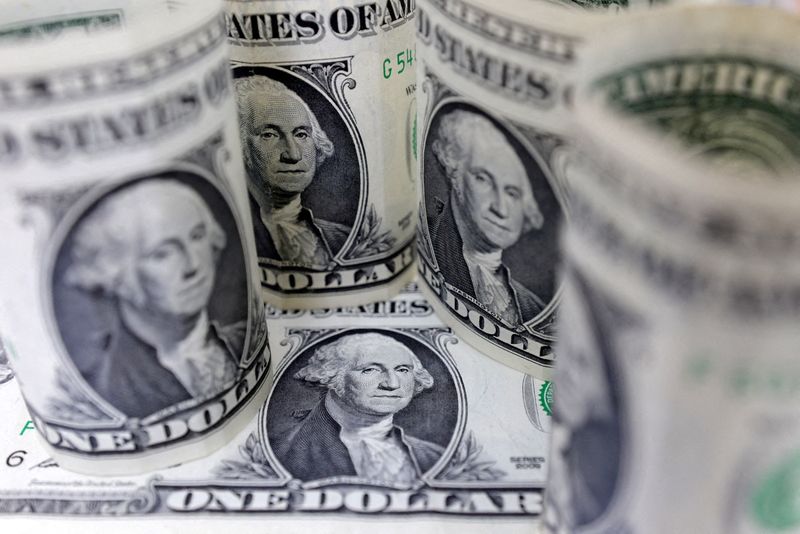
By Alun John
LONDON (Reuters) -The dollar edged towards its highest level this year against a basket of peers and U.S. share futures dipped on Wednesday ahead of a Federal Reserve policy decision, though trading was thin with many European and Asian markets closed.
The dollar gained over 0.5% on Tuesday on the six currencies that make up the , and the gauge rose as high as 106.49 on Wednesday, a whisker off its highest since November.
The euro steadied but was under pressure at $1.0670, not far from its mid April, five-month lows, while the pound was at $1.2478.
The latest move higher in the dollar came after hotter-than-expected first-quarter U.S. employment cost growth on Tuesday, which sent Treasury yields higher and caused markets to further pare bets on Fed rate cuts this year.
Traders are currently only pricing in one rate cut in 2024.
The Fed is almost certain to hold its benchmark overnight interest rate steady later in the day, but a policy statement issued at 1400 EDT (1800 GMT) and Chair Jerome Powell’s press conference half an hour later should provide insight into how deeply – if at all – a stretch of three lost months in the inflation battle has affected the likelihood that borrowing costs will fall any time soon.
“It’s pretty clear from the way that the data has been that we’re going to see a focus shift from the last Fed meeting, the question is the extent to which Powell has already previewed the shift of rhetoric when he last spoke,” said Michael Sneyd, head of cross-asset and macro quantitative strategy at BNP Paribas (OTC:).
remove ads
.
The Fed chair said in mid-April that monetary policy needed to be restrictive for longer.
“Heading into the Fed, we see that from a short-term perspective the dollar is not looking cheap anywhere,” said Sneyd.
The benchmark was flat on the day at 4.686%, just shy of mid-April’s peak of 4.739%, its highest in five months, having jumped 7 basis points (bps) the day before.
European bond markets were closed for the May 1 holiday as were most share markets in Europe and those in China, Hong Kong and much of Asia.
U.S. futures dipped 0.4%, and Nasdaq futures shed 0.65% as chip stocks led losses after downbeat results. [.N]
Amazon.com (NASDAQ:) bucked the trend to rise 2.2% in pre market after reporting quarterly results above market expectations.
Of those share markets that were trading, edged up a touch, holding near its latest all-time intraday high hit the day before, and dipped 0.34%.
The British blue-chip index, which has underperformed world peers in recent months, was a rare gainer in April, rising 2.4%, helped by commodities stocks, while MSCI’s world index dropped 3.4%, its biggest monthly fall since September.
The other focus in currency markets is the Japanese yen. The currency dropped to 160 per dollar on Monday, its lowest since 1990, before strengthening in several sharp bursts to as strong as 154.4 per dollar with traders pointing to likely official intervention.
Japanese officials may have spent some 5.5 trillion yen($35 billion) in supporting the currency on Monday, Bank of Japan data suggested on Tuesday, but the yen was last at 157.9, over half way back to its pre-intervention level.
remove ads
.
Oil prices fell for a third day on Wednesday amid increasing hopes of a ceasefire agreement in the Middle East and rising crude inventories and production in the U.S., the world’s biggest oil consumer.
was down 1.2% at $85.27 a barrel. was down 1.4% at $80.73.
Gold was up 0.5% at $2296.4 an ounce but still down 5.5% from its mid-April record high, also affected by easing tensions in the Middle East.
Forex
Dollar edges higher ahead of key Federal Reserve meeting
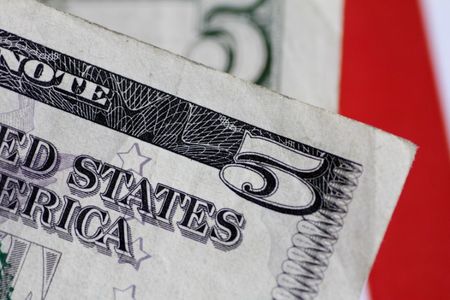
Investing.com – The U.S. dollar edged higher Wednesday, climbing towards its highest level in November ahead of the conclusion of the latest Federal Reserve policy-setting meeting.
At 04:00 ET (09:00 GMT), the Dollar Index, which tracks the greenback against a basket of six other currencies, traded 0.1% higher at 106.240, after earlier climbing as high as 106.380, near the 106.51 mark that would be the highest since Nov. 1.
Does the Fed still see rate cuts this year?
The concludes its latest two-day meeting later in the session, and is widely expected to keep interest rates at the elevated 5.25%-5.5% levels.
Progress towards the Fed’s 2.0% medium-term inflation target has somewhat stalled of late, as typified by Tuesday’s release of the Employment Cost Index, which rose at an elevated 4.2% rate on a year-over-year basis in the first quarter, matching the rise in the fourth quarter.
This has resulted in futures markets pricing in just a single quarter-point rate cut by year-end, from as many as five of those at the start of the year, with this hawkish leaning benefiting the dollar.
The main focus will be on what Chair has to say in his news conference, particularly given the bank won’t be updating economic projections this time around.
Investors will be awaiting indications about whether the Fed still expects to cut interest rates at some stage this year.
Euro calm as inflation holds steady
In Europe, edged higher to 1.0669, trading in limited volumes with much of the European continent on holiday.
remove ads
.
Data released on Tuesday showed that held steady at 2.4% in April, solidifying an already strong case for the to cut interest rates next month.
The ECB all but promised a rate cut on June 6, provided there is no nasty surprise in wage or price developments.
“The ECB’s governing council considers that if this inflation outlook is maintained, it would be appropriate to start reducing the current level of monetary policy tightening in June,” De Cos, who is also head of the Spanish central bank, said in the Bank of Spain’s annual report on Tuesday.
traded largely flat at 1.2491, in subdued trading.
As it currently stands, money markets currently fully price a first quarter-point Bank of England rate cut by its Aug. 1 meeting – with a roughly 50-50 chance of a move as soon as June 20.
Yen retreats; more intervention needed?
In Asia, rose 0.1% to 157.91, with the yen retreating even after suspected government intervention sparked a sharp rebound in the currency.
The pair is still way off the 34-year high of 160.245 seen at the start of the week, but the Japanese authorities will be concerned that the yen appears to be retreating once more, potentially forcing them to enter the market once more.
Other Asian currencies were muted, amid a mix of labor day holidays and caution before the Fed.
rose 0.2% to 0.6482, with the Aussie dollar pair strengthening ahead of next week’s meeting of the .
remove ads
.
The RBA could potentially offer up a hawkish stance following a stronger-than-expected inflation reading for the first quarter.

 Forex2 years ago
Forex2 years agoForex Today: the dollar is gaining strength amid gloomy sentiment at the start of the Fed’s week

 Forex2 years ago
Forex2 years agoHow is the Australian dollar doing today?

 Forex1 year ago
Forex1 year agoUnbiased review of Pocket Option broker

 Forex2 years ago
Forex2 years agoDollar to pound sterling exchange rate today: Pound plummeted to its lowest since 1985

 Cryptocurrency2 years ago
Cryptocurrency2 years agoWhat happened in the crypto market – current events today

 World2 years ago
World2 years agoWhy are modern video games an art form?

 Stock Markets2 years ago
Stock Markets2 years agoMorgan Stanley: bear market rally to continue

 Economy2 years ago
Economy2 years agoCrude oil tankers double in price due to EU anti-Russian sanctions











